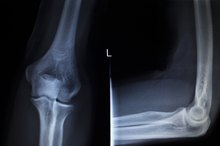What does fact checked mean?
At Healthfully, we strive to deliver objective content that is accurate and up-to-date. Our team periodically reviews articles in order to ensure content quality. The sources cited below consist of evidence from peer-reviewed journals, prominent medical organizations, academic associations, and government data.
The information contained on this site is for informational purposes only, and should not be used as a substitute for the advice of a professional health care provider. Please check with the appropriate physician regarding health questions and concerns. Although we strive to deliver accurate and up-to-date information, no guarantee to that effect is made.
What Causes Fluid on the Elbow?
The condition of having fluid on the elbow is medically known as olecranon bursitis, which afflicts the bursa, a sac-like tissue that protects the area where the ulna and humerus bones connect. This sac moves with the elbow joint and cushions the area against external pressure or trauma. The prominence of the point of the elbow and the lack of protective muscle tissue causes this area to be vulnerable to injury.
If you are experiencing serious medical symptoms, seek emergency treatment immediately.
Problems
The bursa sac normally contains a small amount of fluid to allow it to move around the elbow for protection. The bursa develops problems, such as bursitis, when trauma causes inflammation and bleeding in the bursa sac, which then begins to swell. The walls of the bursa will also thicken and become tender, and may remain in this state for a certain amount of time depending on the cause of the trauma. It then becomes the condition known as olecranon bursitis.
- The bursa sac normally contains a small amount of fluid to allow it to move around the elbow for protection.
- The bursa develops problems, such as bursitis, when trauma causes inflammation and bleeding in the bursa sac, which then begins to swell.
Causes
Fluid on Elbow Symptoms
Learn More
One of the most common causes of bursitis is constant pressure in the elbow area, either from body weight being forced on the elbow (due to regularly leaning on a hard surface, such as a table or a desk) or from continual work- or sports-related movements that put constant pressure on the elbows. This may not necessarily cause swelling of the bursa with fluid, but it will make the bursa walls thicken and remain in that condition due to the constant pressure being placed in the area.
Other Causes
A blow to the area or a fall on the elbow will prompt bleeding into the bursa sac, causing swelling and inflammation. Injury will also thicken the walls of the bursa, and they will remain swollen for some time even after the blood has been absorbed back into the body. An infection from a sore or wound over the area will also cause bursitis. The bursa will fill with pus from the infection and will become hot and tender. The swelling will generally be temporary until the area recovers from the trauma.
- A blow to the area or a fall on the elbow will prompt bleeding into the bursa sac, causing swelling and inflammation.
- The bursa will fill with pus from the infection and will become hot and tender.
Symptoms
Elbow Skin Pain
Learn More
The elbows will be tender and red, and lumps may be felt in the area. These lumps are from folds of the bursa that have swollen because of constant inflammation. A thickening of the skin over the elbow may occur over time 1. If the bursa is infected, a fever or ague-like symptoms may accompany the tenderness, and the elbow will feel hot. In all of these cases, a doctor will be able to diagnose bursitis either by a physical examination, an X-ray or taking a sample of the fluid in the bursa sac to test for infection.
- The elbows will be tender and red, and lumps may be felt in the area.
Treatment
If swelling occurs from chronic bursitis, relief of pressure on the elbow and a period of rest will alleviate symptoms, and physical therapy may also be recommended. Ibuprofen or aspirin may be prescribed for swelling and pain. If an infection has caused the condition, the sac could be drained by needle injection and antibiotics prescribed to fight off the infection. In cases of physical trauma, the swelling usually recedes on its own. Drainage by needle injection may be necessary in some instances, and cortisone may be used to combat swelling and inflammation.
- If swelling occurs from chronic bursitis, relief of pressure on the elbow and a period of rest will alleviate symptoms, and physical therapy may also be recommended.
- Drainage by needle injection may be necessary in some instances, and cortisone may be used to combat swelling and inflammation.
Related Articles
References
- National Library of Medicine
- Hand University
- Taylor SA, Hannafin JA. Evaluation and Management of Elbow Tendinopathy. Sports Health. 2012;4(5):384-393. doi:10.1177/1941738112454651
- Khodaee M. Common Superficial Bursitis. Am Fam Physician. 2017;95(4):224-231.
- Hubbard MJ, Hildebrand BA, Battafarano MM, Battafarano DF. Common Soft Tissue Musculoskeletal Pain Disorders. Prim Care. 2018;45(2):289-303. doi:10.1016/j.pop.2018.02.006
- Bracilovic A. Septic Bursitis. Veritas Health, LLC. Updated November 21, 2019.
- Blackwell JR, Hay BA, Bolt AM, Hay SM. Olecranon bursitis: a systematic overview. Shoulder Elbow. 2014;6(3):182-190. doi:10.1177/1758573214532787
- InformedHealth.org. Bursitis: Overview. Cologne, Germany: Institute for Quality and Efficiency in Health Care (IQWiG); 2006.
- InformedHealth.org. How can bursitis be treated? Cologne, Germany: Institute for Quality and Efficiency in Health Care (IQWiG); 2006.
- Patel J, Girishkumar, Mruthyunjaya, Rupakumar CS. Bilateral Olecranon Bursitis - A Rare Clinical presentation of Calcium Pyrophosphate Crystal Deposition Disease. J Orthop Case Rep. 2014;4(1):3-6. doi:10.13107/jocr.2250-0685.137
- Lockman L. Treating nonseptic olecranon bursitis: a 3-step technique. Can Fam Physician. 2010;56(11):1157.
- Sayegh ET, Strauch RJ. Treatment of olecranon bursitis: a systematic review. Arch Orthop Trauma Surg. 2014;134(11):1517-1536.
- Aaron DL, et al. "Four Common Types of Bursitis: Diagnosis and Management." J Am Acad Orthop Surg June 2011; 19:359-367.







